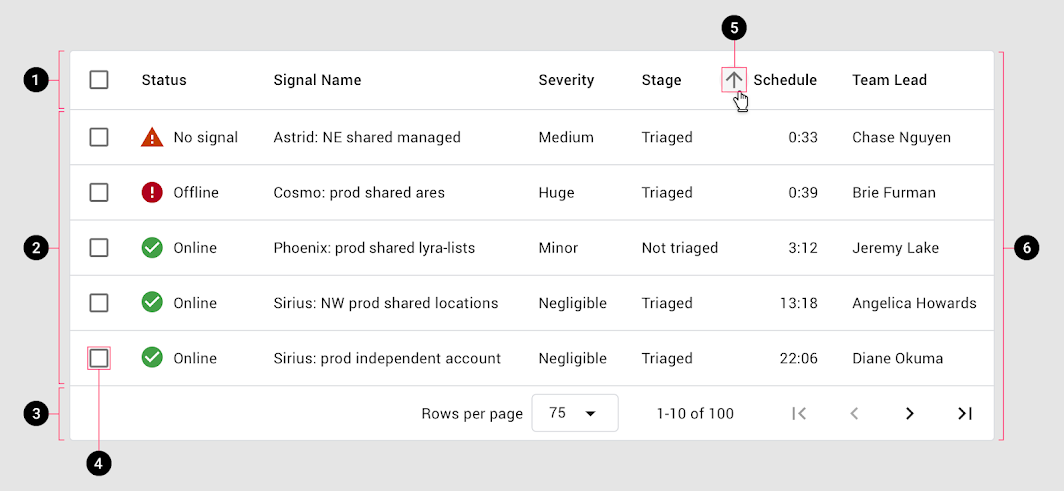Make a Material table header fix
Learn how to fix headers in material tables for a seamless user experience.

Published At
8/12/2020
Reading Time
~ 2 min read
If you see the below code, you'll find out that I've removed the data rows from the first table and header row from the second table. and then added a tableHeader and tableData ids to both table.
<table
mat-table
[dataSource]="dataSource"
class="mat-elevation-z8"
id="tableHeader"
>
<ng-container matColumnDef="position">
<th mat-header-cell *matHeaderCellDef>No.</th>
</ng-container>
<ng-container matColumnDef="name">
<th mat-header-cell *matHeaderCellDef>Name</th>
</ng-container>
<ng-container matColumnDef="weight">
<th mat-header-cell *matHeaderCellDef>Weight</th>
</ng-container>
<ng-container matColumnDef="symbol">
<th mat-header-cell *matHeaderCellDef>Symbol</th>
</ng-container>
<tr mat-header-row *matHeaderRowDef="displayedColumns"></tr>
</table>
<table
mat-table
[dataSource]="dataSource"
class="mat-elevation-z8"
id="tableData"
>
<ng-container matColumnDef="position">
<th mat-header-cell *matHeaderCellDef>No.</th>
<td mat-cell *matCellDef="let element">{{element.position}}</td>
</ng-container>
<ng-container matColumnDef="name">
<th mat-header-cell *matHeaderCellDef>Name</th>
<td mat-cell *matCellDef="let element">{{element.name}}</td>
</ng-container>
<ng-container matColumnDef="weight">
<th mat-header-cell *matHeaderCellDef>Weight</th>
<td mat-cell *matCellDef="let element">{{element.weight}}</td>
</ng-container>
<ng-container matColumnDef="symbol">
<th mat-header-cell *matHeaderCellDef>Symbol</th>
<td mat-cell *matCellDef="let element">{{element.symbol}}</td>
</ng-container>
<tr mat-row *matRowDef="let row; columns: displayedColumns;"></tr>
</table><table
mat-table
[dataSource]="dataSource"
class="mat-elevation-z8"
id="tableHeader"
>
<ng-container matColumnDef="position">
<th mat-header-cell *matHeaderCellDef>No.</th>
</ng-container>
<ng-container matColumnDef="name">
<th mat-header-cell *matHeaderCellDef>Name</th>
</ng-container>
<ng-container matColumnDef="weight">
<th mat-header-cell *matHeaderCellDef>Weight</th>
</ng-container>
<ng-container matColumnDef="symbol">
<th mat-header-cell *matHeaderCellDef>Symbol</th>
</ng-container>
<tr mat-header-row *matHeaderRowDef="displayedColumns"></tr>
</table>
<table
mat-table
[dataSource]="dataSource"
class="mat-elevation-z8"
id="tableData"
>
<ng-container matColumnDef="position">
<th mat-header-cell *matHeaderCellDef>No.</th>
<td mat-cell *matCellDef="let element">{{element.position}}</td>
</ng-container>
<ng-container matColumnDef="name">
<th mat-header-cell *matHeaderCellDef>Name</th>
<td mat-cell *matCellDef="let element">{{element.name}}</td>
</ng-container>
<ng-container matColumnDef="weight">
<th mat-header-cell *matHeaderCellDef>Weight</th>
<td mat-cell *matCellDef="let element">{{element.weight}}</td>
</ng-container>
<ng-container matColumnDef="symbol">
<th mat-header-cell *matHeaderCellDef>Symbol</th>
<td mat-cell *matCellDef="let element">{{element.symbol}}</td>
</ng-container>
<tr mat-row *matRowDef="let row; columns: displayedColumns;"></tr>
</table>Now, we'll get the width of each column from the second table and reflect them in the first to fix the header.
const headerTable = document.querySelector('#tableHeader')
const dataTable = document.querySelector('#tableData')
/**
* Get width of each column named "dataWidths" and
* Fix first and last column width by subtraction 24px
* as left and right padding was styled into the first and last column of the table
* */
const dataWidths = [...dataTable.children[1].children[0].children].map(
cell => cell.offsetWidth
)
dataWidths[0] = dataWidths[0] - 24
dataWidths[dataWidths.length - 1] = dataWidths[dataWidths.length - 1] - 24
const headerColumns = [...headerTable.children[0].children[0].children]
headerColumns.map(column => {
column.style.width = dataWidths[count] + 'px'
count++
})const headerTable = document.querySelector('#tableHeader')
const dataTable = document.querySelector('#tableData')
/**
* Get width of each column named "dataWidths" and
* Fix first and last column width by subtraction 24px
* as left and right padding was styled into the first and last column of the table
* */
const dataWidths = [...dataTable.children[1].children[0].children].map(
cell => cell.offsetWidth
)
dataWidths[0] = dataWidths[0] - 24
dataWidths[dataWidths.length - 1] = dataWidths[dataWidths.length - 1] - 24
const headerColumns = [...headerTable.children[0].children[0].children]
headerColumns.map(column => {
column.style.width = dataWidths[count] + 'px'
count++
})🙏
Do you have any questions, or simply wish to contact me privately? Don't hesitate to shoot me a DM on Twitter.
Have a wonderful day.
Abhishek 🙏